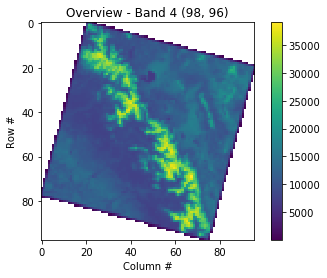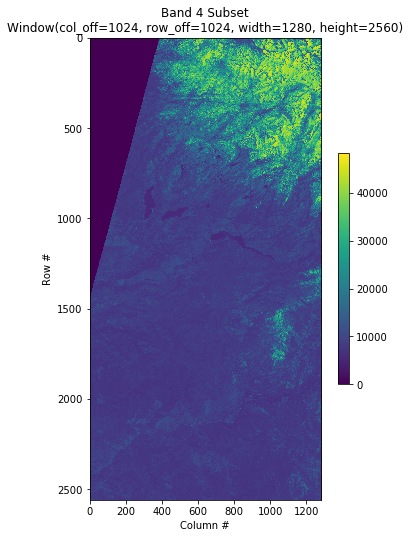Read Cloud Optimized Geotiffs¶
The following materials are based on this tutorial. Read more from that tutorial until this one get’s better updated.
- Let’s read a Landsat TIF profile from AWS cloud storage:
In [9]:
import rasterio
import matplotlib.pyplot as plt
import numpy as np
# Specify the path for Landsat TIF on AWS
fp = 'http://landsat-pds.s3.amazonaws.com/c1/L8/042/034/LC08_L1TP_042034_20170616_20170629_01_T1/LC08_L1TP_042034_20170616_20170629_01_T1_B4.TIF'
# See the profile
with rasterio.open(fp) as src:
print(src.profile)
{'driver': 'GTiff', 'dtype': 'uint16', 'nodata': None, 'width': 7821, 'height': 7951, 'count': 1, 'crs': CRS({'init': 'epsg:32611'}), 'transform': Affine(30.0, 0.0, 204285.0,
0.0, -30.0, 4268115.0), 'blockxsize': 512, 'blockysize': 512, 'tiled': True, 'compress': 'deflate', 'interleave': 'band'}
- Let’s plot a low resolution overview:
In [7]:
%matplotlib inline
# Open the COG
with rasterio.open(fp) as src:
# List of overviews from biggest to smallest
oviews = src.overviews(1)
# Retrieve the smallest thumbnail
oview = oviews[-1]
print('Decimation factor= {}'.format(oview))
# NOTE this is using a 'decimated read' (http://rasterio.readthedocs.io/en/latest/topics/resampling.html)
thumbnail = src.read(1, out_shape=(1, int(src.height // oview), int(src.width // oview)))
print('array type: ',type(thumbnail))
print(thumbnail)
plt.imshow(thumbnail)
plt.colorbar()
plt.title('Overview - Band 4 {}'.format(thumbnail.shape))
plt.xlabel('Column #')
plt.ylabel('Row #')
Decimation factor= 81
array type: <class 'numpy.ndarray'>
[[0 0 0 ..., 0 0 0]
[0 0 0 ..., 0 0 0]
[0 0 0 ..., 0 0 0]
...,
[0 0 0 ..., 0 0 0]
[0 0 0 ..., 0 0 0]
[0 0 0 ..., 0 0 0]]
Out[7]:
<matplotlib.text.Text at 0x1b6fdc750f0>

- Let’s fix the NoData values to be
NaNinstead of 0:
In [10]:
# Open the file
with rasterio.open(fp) as src:
# Access the overviews
oviews = src.overviews(1)
oview = oviews[-1]
print('Decimation factor= {}'.format(oview))
# Read the thumbnail
thumbnail = src.read(1, out_shape=(1, int(src.height // oview), int(src.width // oview)))
# Convert the values into float
thumbnail = thumbnail.astype('f4')
# Convert 0 values to NaNs
thumbnail[thumbnail==0] = np.nan
plt.imshow(thumbnail)
plt.colorbar()
plt.title('Overview - Band 4 {}'.format(thumbnail.shape))
plt.xlabel('Column #')
plt.ylabel('Row #')
Decimation factor= 81
Out[10]:
<matplotlib.text.Text at 0x1b6fdf546d8>

- Let’s take a subset from high resolution image:
In [11]:
#https://rasterio.readthedocs.io/en/latest/topics/windowed-rw.html
#rasterio.windows.Window(col_off, row_off, width, height)
window = rasterio.windows.Window(1024, 1024, 1280, 2560)
with rasterio.open(fp) as src:
subset = src.read(1, window=window)
plt.figure(figsize=(6,8.5))
plt.imshow(subset)
plt.colorbar(shrink=0.5)
plt.title(f'Band 4 Subset\n{window}')
plt.xlabel('Column #')
plt.ylabel('Row #')
Out[11]:
<matplotlib.text.Text at 0x1b6fe014390>

These commands demonstrate the basics how to use COGs to retrieve data from the cloud.

